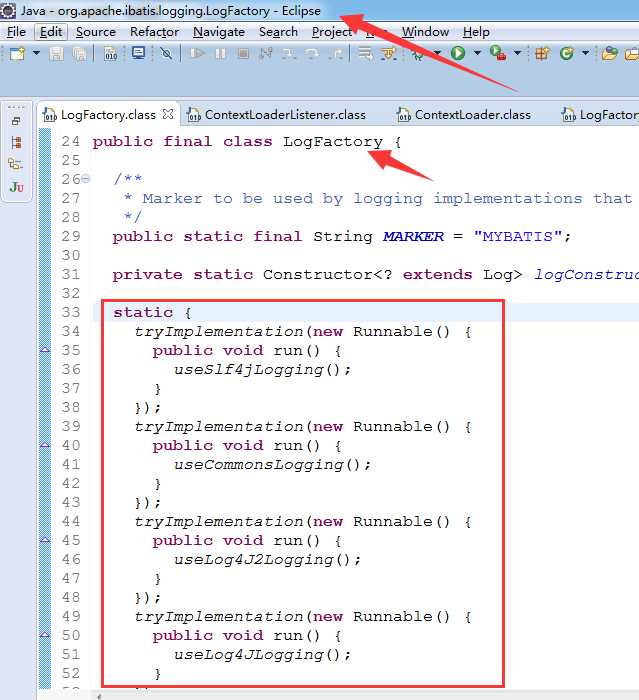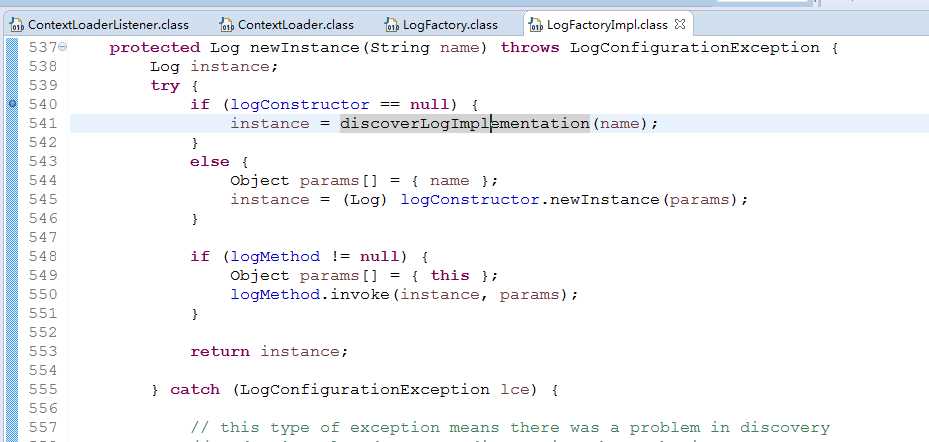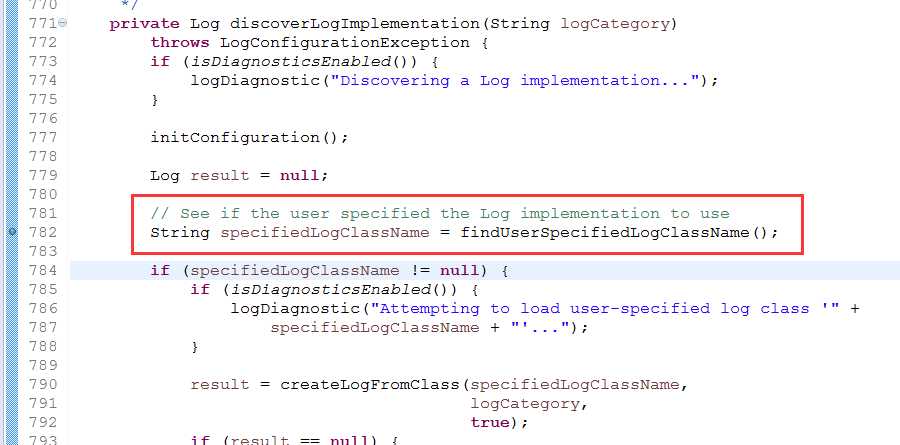标签:discovery asm pre dia pac environ ssl 导入 内容
项目用的是springmvc+spring+mybatis框架,
配置日志的时候非常简单,仅仅是把commons-logging、log4j,还有slf4j-log4j三个日志相关的jar包导入项目,然后在classpath中加个log4j.properties的配置文件即可。
但是你有没有想过Log4j是什么时候被加载进虚拟机的?为什么我们没有手动加载,spring和mybatis就能自动的用起来log4j,毫不见外?
spring使用的是commons-logging,

mybatis用的是自己写的,

看一下源码,非常简单,一个个的去试,没有这个就进入下一个,直到找到了log4j

这两个工具其实都只是日志工具的规范,可以理解成接口,而log4j才是一个实实在在的日志实现。
但是slf4j在什么地方?——虽然这两个工具没用到slf4j,我还是把它放进来,因为我引入的其他工具会用到它。。比如:

下面开始看代码代码来说明一下log4j是怎么被加载到虚拟机的,并且为什么spring和mybatis都会用log4j:
首先我们来看spring,我们从web.xml看起,加载spring:



到这里我们看到了LogFactory,这是commons-logging的一个log工厂,这里用的是这个虚类的一个静态方法,我们继续看这个方法:

再看getFactory:
1 public static LogFactory getFactory() throws LogConfigurationException { 2 // Identify the class loader we will be using 3 ClassLoader contextClassLoader = getContextClassLoaderInternal(); 4 5 if (contextClassLoader == null) { 6 // This is an odd enough situation to report about. This 7 // output will be a nuisance on JDK1.1, as the system 8 // classloader is null in that environment. 9 if (isDiagnosticsEnabled()) { 10 logDiagnostic("Context classloader is null."); 11 } 12 } 13 14 // Return any previously registered factory for this class loader 15 LogFactory factory = getCachedFactory(contextClassLoader); 16 if (factory != null) { 17 return factory; 18 } 19 20 if (isDiagnosticsEnabled()) { 21 logDiagnostic( 22 "[LOOKUP] LogFactory implementation requested for the first time for context classloader " + 23 objectId(contextClassLoader)); 24 logHierarchy("[LOOKUP] ", contextClassLoader); 25 } 26 27 // Load properties file. 28 // 29 // If the properties file exists, then its contents are used as 30 // "attributes" on the LogFactory implementation class. One particular 31 // property may also control which LogFactory concrete subclass is 32 // used, but only if other discovery mechanisms fail.. 33 // 34 // As the properties file (if it exists) will be used one way or 35 // another in the end we may as well look for it first. 36 37 Properties props = getConfigurationFile(contextClassLoader, FACTORY_PROPERTIES); 38 39 // Determine whether we will be using the thread context class loader to 40 // load logging classes or not by checking the loaded properties file (if any). 41 ClassLoader baseClassLoader = contextClassLoader; 42 if (props != null) { 43 String useTCCLStr = props.getProperty(TCCL_KEY); 44 if (useTCCLStr != null) { 45 // The Boolean.valueOf(useTCCLStr).booleanValue() formulation 46 // is required for Java 1.2 compatibility. 47 if (Boolean.valueOf(useTCCLStr).booleanValue() == false) { 48 // Don‘t use current context classloader when locating any 49 // LogFactory or Log classes, just use the class that loaded 50 // this abstract class. When this class is deployed in a shared 51 // classpath of a container, it means webapps cannot deploy their 52 // own logging implementations. It also means that it is up to the 53 // implementation whether to load library-specific config files 54 // from the TCCL or not. 55 baseClassLoader = thisClassLoader; 56 } 57 } 58 } 59 60 // Determine which concrete LogFactory subclass to use. 61 // First, try a global system property 62 if (isDiagnosticsEnabled()) { 63 logDiagnostic("[LOOKUP] Looking for system property [" + FACTORY_PROPERTY + 64 "] to define the LogFactory subclass to use..."); 65 } 66 67 try { 68 String factoryClass = getSystemProperty(FACTORY_PROPERTY, null); 69 if (factoryClass != null) { 70 if (isDiagnosticsEnabled()) { 71 logDiagnostic("[LOOKUP] Creating an instance of LogFactory class ‘" + factoryClass + 72 "‘ as specified by system property " + FACTORY_PROPERTY); 73 } 74 factory = newFactory(factoryClass, baseClassLoader, contextClassLoader); 75 } else { 76 if (isDiagnosticsEnabled()) { 77 logDiagnostic("[LOOKUP] No system property [" + FACTORY_PROPERTY + "] defined."); 78 } 79 } 80 } catch (SecurityException e) { 81 if (isDiagnosticsEnabled()) { 82 logDiagnostic("[LOOKUP] A security exception occurred while trying to create an" + 83 " instance of the custom factory class" + ": [" + trim(e.getMessage()) + 84 "]. Trying alternative implementations..."); 85 } 86 // ignore 87 } catch (RuntimeException e) { 88 // This is not consistent with the behaviour when a bad LogFactory class is 89 // specified in a services file. 90 // 91 // One possible exception that can occur here is a ClassCastException when 92 // the specified class wasn‘t castable to this LogFactory type. 93 if (isDiagnosticsEnabled()) { 94 logDiagnostic("[LOOKUP] An exception occurred while trying to create an" + 95 " instance of the custom factory class" + ": [" + 96 trim(e.getMessage()) + 97 "] as specified by a system property."); 98 } 99 throw e; 100 } 101 102 // Second, try to find a service by using the JDK1.3 class 103 // discovery mechanism, which involves putting a file with the name 104 // of an interface class in the META-INF/services directory, where the 105 // contents of the file is a single line specifying a concrete class 106 // that implements the desired interface. 107 108 if (factory == null) { 109 if (isDiagnosticsEnabled()) { 110 logDiagnostic("[LOOKUP] Looking for a resource file of name [" + SERVICE_ID + 111 "] to define the LogFactory subclass to use..."); 112 } 113 try { 114 final InputStream is = getResourceAsStream(contextClassLoader, SERVICE_ID); 115 116 if( is != null ) { 117 // This code is needed by EBCDIC and other strange systems. 118 // It‘s a fix for bugs reported in xerces 119 BufferedReader rd; 120 try { 121 rd = new BufferedReader(new InputStreamReader(is, "UTF-8")); 122 } catch (java.io.UnsupportedEncodingException e) { 123 rd = new BufferedReader(new InputStreamReader(is)); 124 } 125 126 String factoryClassName = rd.readLine(); 127 rd.close(); 128 129 if (factoryClassName != null && ! "".equals(factoryClassName)) { 130 if (isDiagnosticsEnabled()) { 131 logDiagnostic("[LOOKUP] Creating an instance of LogFactory class " + 132 factoryClassName + 133 " as specified by file ‘" + SERVICE_ID + 134 "‘ which was present in the path of the context classloader."); 135 } 136 factory = newFactory(factoryClassName, baseClassLoader, contextClassLoader ); 137 } 138 } else { 139 // is == null 140 if (isDiagnosticsEnabled()) { 141 logDiagnostic("[LOOKUP] No resource file with name ‘" + SERVICE_ID + "‘ found."); 142 } 143 } 144 } catch (Exception ex) { 145 // note: if the specified LogFactory class wasn‘t compatible with LogFactory 146 // for some reason, a ClassCastException will be caught here, and attempts will 147 // continue to find a compatible class. 148 if (isDiagnosticsEnabled()) { 149 logDiagnostic( 150 "[LOOKUP] A security exception occurred while trying to create an" + 151 " instance of the custom factory class" + 152 ": [" + trim(ex.getMessage()) + 153 "]. Trying alternative implementations..."); 154 } 155 // ignore 156 } 157 } 158 159 // Third try looking into the properties file read earlier (if found) 160 161 if (factory == null) { 162 if (props != null) { 163 if (isDiagnosticsEnabled()) { 164 logDiagnostic( 165 "[LOOKUP] Looking in properties file for entry with key ‘" + FACTORY_PROPERTY + 166 "‘ to define the LogFactory subclass to use..."); 167 } 168 String factoryClass = props.getProperty(FACTORY_PROPERTY); 169 if (factoryClass != null) { 170 if (isDiagnosticsEnabled()) { 171 logDiagnostic( 172 "[LOOKUP] Properties file specifies LogFactory subclass ‘" + factoryClass + "‘"); 173 } 174 factory = newFactory(factoryClass, baseClassLoader, contextClassLoader); 175 176 // TODO: think about whether we need to handle exceptions from newFactory 177 } else { 178 if (isDiagnosticsEnabled()) { 179 logDiagnostic("[LOOKUP] Properties file has no entry specifying LogFactory subclass."); 180 } 181 } 182 } else { 183 if (isDiagnosticsEnabled()) { 184 logDiagnostic("[LOOKUP] No properties file available to determine" + " LogFactory subclass from.."); 185 } 186 } 187 } 188 189 // Fourth, try the fallback implementation class 190 191 if (factory == null) { 192 if (isDiagnosticsEnabled()) { 193 logDiagnostic( 194 "[LOOKUP] Loading the default LogFactory implementation ‘" + FACTORY_DEFAULT + 195 "‘ via the same classloader that loaded this LogFactory" + 196 " class (ie not looking in the context classloader)."); 197 } 198 199 // Note: unlike the above code which can try to load custom LogFactory 200 // implementations via the TCCL, we don‘t try to load the default LogFactory 201 // implementation via the context classloader because: 202 // * that can cause problems (see comments in newFactory method) 203 // * no-one should be customising the code of the default class 204 // Yes, we do give up the ability for the child to ship a newer 205 // version of the LogFactoryImpl class and have it used dynamically 206 // by an old LogFactory class in the parent, but that isn‘t 207 // necessarily a good idea anyway. 208 factory = newFactory(FACTORY_DEFAULT, thisClassLoader, contextClassLoader); 209 } 210 211 if (factory != null) { 212 /** 213 * Always cache using context class loader. 214 */ 215 cacheFactory(contextClassLoader, factory); 216 217 if (props != null) { 218 Enumeration names = props.propertyNames(); 219 while (names.hasMoreElements()) { 220 String name = (String) names.nextElement(); 221 String value = props.getProperty(name); 222 factory.setAttribute(name, value); 223 } 224 } 225 } 226 227 return factory; 228 }
以上代码会先视图从classpath中加载commons-logging.properties等几个commons-logging才有的东西,直到208行代码,

我们看到最后创建了一个LogFactoryImpl的实例,然后返回了。
回头看看我们上边的代码:

看完了getFactory我们知道最后我们得到的是LogFactoryImpl的实例,
那么接下来我们该去这个类中看看它的getInstance方法了:

非常简单,在这里创建了一个Log的实例,这也是最关键的地方,我们去看看这个方法。

经过我个人进一步的代码分析logConstructor这个东西是空的,我就不再展开了,这时我们看541行这个方法,这里才是真正的创建Log实例:

这个方法名我们能看懂,就是去发现系统中的Log实现,也就是一个找的过程,后边的782行是找找系统变量中有没有commons-logging自己的指明实现类类名的变量,结果是没有的。
这个方法还没完,中间是一大段的注释,我们直接看后边的重点:

这个时候开始遍历一个字符串数组,依此去系统中找有没有这个数组中的实现类,我们看看这个数组先。


大家看到了什么?log4j,现在大家基本已经知道为什么了,后边的代码如果还有兴趣可以自己去看,其实就是一个个的试着去系统中加载这些类,加载不到处理一下ClassNotFoundException然后继续找下一个。
完毕。
最后如果大家想看看commons-logging自己的日志,可以写一个Listener放在web xml第一个位置,把下边一句代码弄上:

你们会从日志中看到多了很多内容,其中有一句是:
[LogFactoryImpl@1302539661 from org.apache.catalina.loader.WebappClassLoader@1536551745] Class ‘org.apache.commons.logging.impl.Log4JLogger‘ was found at ‘jar:file:/E:/eaipweb/wtpwebapps/EAIP/WEB-INF/lib/commons-logging-1.1.1.jar!/org/apache/commons/logging/impl/Log4JLogger.class‘
这回真完毕了。
标签:discovery asm pre dia pac environ ssl 导入 内容
原文地址:http://www.cnblogs.com/flying607/p/6560851.html